Nucleus paragigantocellularis afferents in male and female rats: organization, gonadal steroid receptor expression, and activation during sexual behavior
- PMID: 18393295
- PMCID: PMC2823478
- DOI: 10.1002/cne.21704
Nucleus paragigantocellularis afferents in male and female rats: organization, gonadal steroid receptor expression, and activation during sexual behavior
Abstract
The supraspinal regulation of genital reflexes is poorly understood. The brainstem nucleus paragigantocellularis (nPGi) of rats is a well-established source of tonic inhibition of genital reflexes. However, the organization, gonadal steroid receptor expression, and activity of nPGi afferents during sex have not been fully characterized in male and female rats. To delineate the anatomical and physiological organization of nPGi afferents, the retrograde tracer Fluoro-Gold (FG) was injected into the nPGi of sexually experienced male and female rats. Animals engaged in sexual behavior 1 hour before sacrifice. Cells containing FG, estrogen receptor-alpha (ER(alpha)), androgen receptor (AR), and the immediate-early gene product Fos were identified immunocytochemically. Retrograde labeling from the nPGi was prominent in the bed nucleus of the stria terminalis, paraventricular nucleus (PVN), posterior hypothalamus, precommissural nucleus, deep mesencephalic nucleus, and periaqueductal gray (PAG) of both sexes. Sex differences were observed in the caudal medial preoptic area (MPO), with significantly more FG+ cells observed in males, and in the PAG and inferior colliculus, where significantly more FG+ cells were observed in females. The majority of regions that contained FG+ cells also contained ER(alpha) or AR, indicating sensitivity to gonadal steroids. The proportions of FG+ cells that co-localized with sex-induced Fos was high in the PVN of both sexes and high in the MPO of males but low in the PAG of both sexes despite the large number of PAG-nPGi output neurons and Fos+ cells in both sexes. The characterization of these afferents will lead to a further understanding of the neural regulation of genital reflexes.
Figures




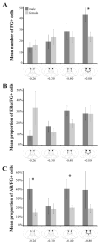
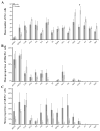

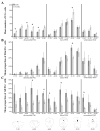
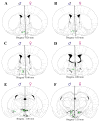







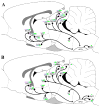
Similar articles
-
Distribution of gonadal steroid receptor-containing neurons in the preoptic-periaqueductal gray-brainstem pathway: a potential circuit for the initiation of male sexual behavior.J Comp Neurol. 2001 Sep 17;438(2):191-212. doi: 10.1002/cne.1309. J Comp Neurol. 2001. PMID: 11536188
-
Identification of neural pathways involved in genital reflexes in the female: a combined anterograde and retrograde tracing study.Neuroscience. 2004;127(3):723-36. doi: 10.1016/j.neuroscience.2004.04.063. Neuroscience. 2004. PMID: 15283970
-
Identification of neural circuits involved in female genital responses in the rat: a dual virus and anterograde tracing study.Am J Physiol Regul Integr Comp Physiol. 2006 Aug;291(2):R419-28. doi: 10.1152/ajpregu.00864.2005. Epub 2006 Feb 16. Am J Physiol Regul Integr Comp Physiol. 2006. PMID: 16914428 Free PMC article.
-
Sex differences in circadian timing systems: implications for disease.Front Neuroendocrinol. 2014 Jan;35(1):111-39. doi: 10.1016/j.yfrne.2013.11.003. Epub 2013 Nov 25. Front Neuroendocrinol. 2014. PMID: 24287074 Free PMC article. Review.
-
Implications of immediate-early gene induction in the brain following sexual stimulation of female and male rodents.Brain Res Bull. 1997;44(4):397-407. doi: 10.1016/s0361-9230(97)00219-0. Brain Res Bull. 1997. PMID: 9370204 Review.
Cited by
-
Sexually differentiated and neuroanatomically specific co-expression of aromatase neurons and GAD67 in the male and female quail brain.Eur J Neurosci. 2020 Aug;52(3):2963-2981. doi: 10.1111/ejn.14765. Epub 2020 Jun 10. Eur J Neurosci. 2020. PMID: 32349174 Free PMC article.
-
Mapping Central Projection of Oxytocin Neurons in Unmated Mice Using Cre and Alkaline Phosphatase Reporter.Front Neuroanat. 2020 Oct 19;14:559402. doi: 10.3389/fnana.2020.559402. eCollection 2020. Front Neuroanat. 2020. PMID: 33192340 Free PMC article.
-
Comparison of pain modulatory effect of the LPGi estragon receptor on inflammatory pain between pro-estrus and estrus phases and OVX rats.Psychopharmacology (Berl). 2025 Jan;242(1):129-147. doi: 10.1007/s00213-024-06653-2. Epub 2024 Aug 24. Psychopharmacology (Berl). 2025. PMID: 39180591
-
Rapid regulation of brain oestrogen synthesis: the behavioural roles of oestrogens and their fates.J Neuroendocrinol. 2009 Mar;21(3):217-26. doi: 10.1111/j.1365-2826.2009.01822.x. Epub 2009 Jan 15. J Neuroendocrinol. 2009. PMID: 19207825 Free PMC article. Review.
-
Excitotoxic lesions of the nucleus paragigantocellularis facilitate male sexual behavior but attenuate female sexual behavior in rats.Neuroscience. 2011 Feb 23;175:212-23. doi: 10.1016/j.neuroscience.2010.11.030. Epub 2010 Dec 7. Neuroscience. 2011. PMID: 21144886 Free PMC article.
References
-
- Brozoski TJ, Ciobanu L, Bauer CA. Central neural activity in rats with tinnitus evaluated with manganese-enhanced magnetic resonance imaging (MEMRI) Hearing research. 2007;228(1–2):168–179. - PubMed
-
- Cameron A, Tomlin M. The effect of male erectile dysfunction on the psychosocial, relationship, and sexual characteristics of heterosexual women in the United States. J Sex Marital Ther. 2007;33(2):135–149. - PubMed
-
- Canteras NS, Goto M. Connections of the precommissural nucleus. J Comp Neurol. 1999;408(1):23–45. - PubMed
Publication types
MeSH terms
Substances
Grants and funding
LinkOut - more resources
Full Text Sources
Research Materials
Miscellaneous

